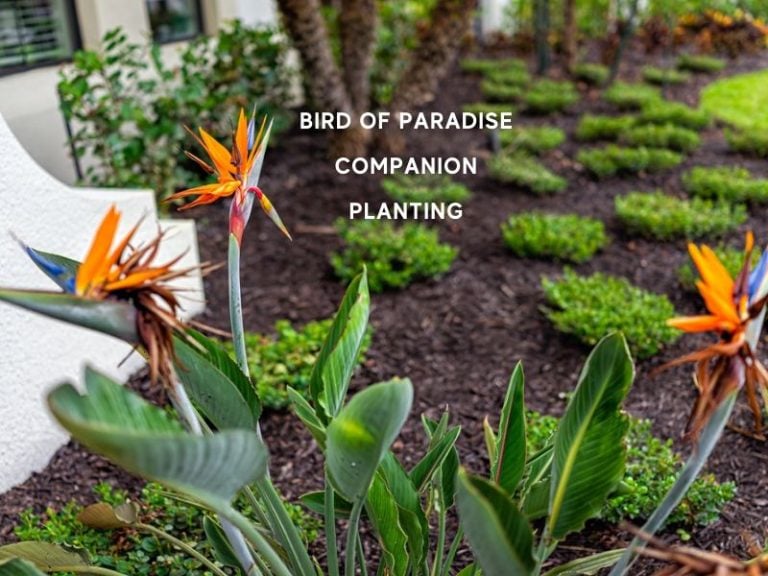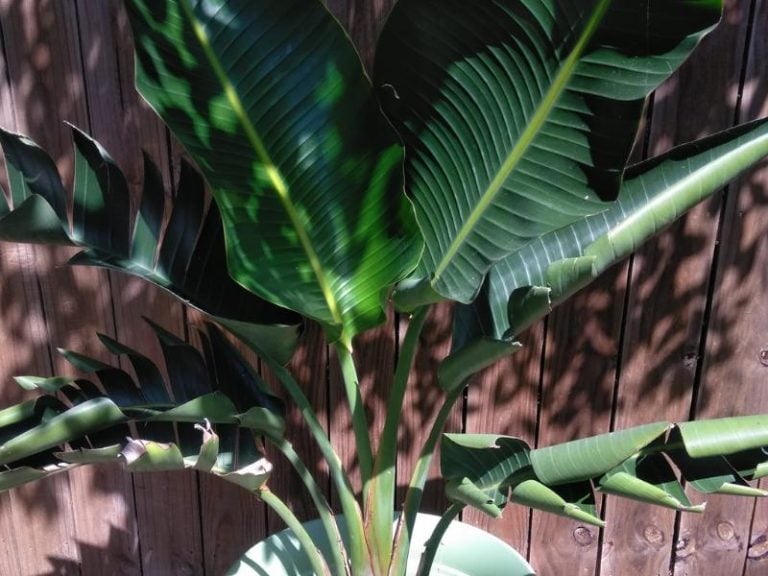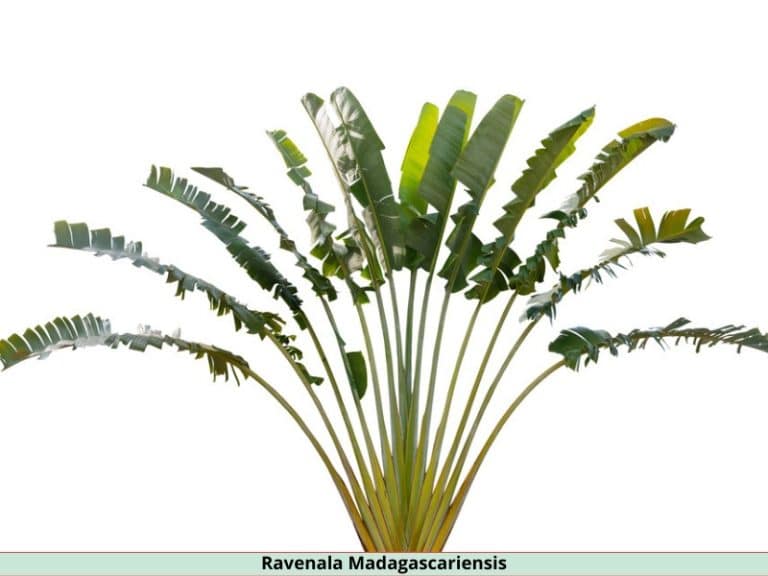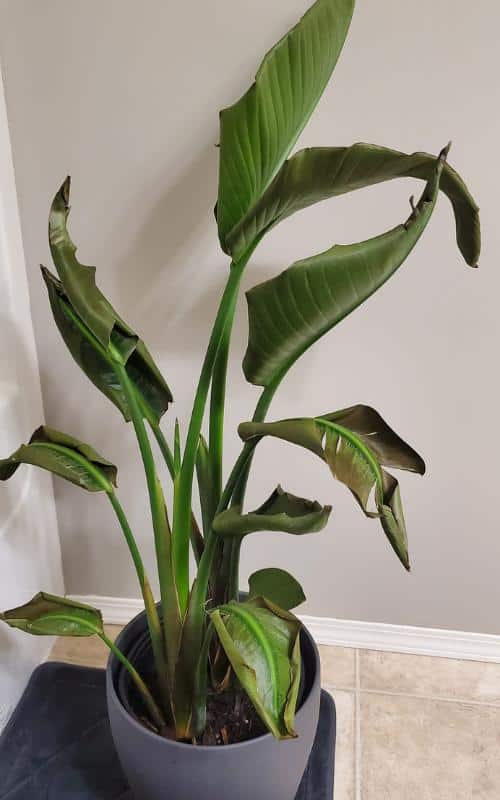Traveler’s Palm vs. Bird of Paradise: How to Tell the Difference
The traveler’s palm and the bird of paradise are among the most notable tropical and sub-tropical plant species for landscaping. They have broad, waxy leaves and beautiful fan-like structures accentuating the appearance of the yard or garden. However, these two beauties are often mistaken for the other, yet they are distinct.
The leaves of these plants are the primary structures used to separate them. The traveler’s palm has robust leaves with an East-West orientation. They emerge from a long petiole radiating from the center of the plant. Meanwhile, the bird of paradise leaves are smaller and usually appear on a stem protruding from the ground.
The traveler’s palm – in general- is one of the plants that look similar to the bird of paradise, so you want to be very keen to identify the differences between them.
Is a bird of paradise a palm?
The bird of paradise is not a palm tree. These two are entirely different plants.
The bird of paradise and palm are from different families. Palm belongs to the Arecaceae family, while the bird of paradise plant belongs to the Strelitziaceae family.
The flowers of these two plants can also be used to distinguish them. The palm tree flowers are small and unrecognizable. They are yellowish-green or light green. They are in a green bract structure resembling the bird of paradise plant’s bract structure.
Meanwhile, the bird of paradise flowers are brightly colored, prominent, and easily noticeable. They are the focal point of this plant. The inflorescence is stuck on top of each other, with red, orange, yellow, or blue petals emerging from a green bract. The dramatic inflorescence resembles a bird in flight.
Traveler’s palm vs. bird of paradise – Differences

Choosing between the traveler’s palm and the bird of paradise plant for landscaping may seem easy until you take an eternity to decide.
Both plants are attractive and look almost similar. But, some features are distinct, which can help you choose correctly. Knowing these finer differences will simplify your decision-making, and you will have the plant that fits your yard or garden.
Growing heights
The traveler’s palm is tall, while the bird of paradise plant is short.
Traveler’s palms grow intensively, and mature trees reach 35-50 feet. They can also grow in clumps, spreading to about 20 feet wide.
On the other hand, the bird of paradise plant grows to a shorter height than the traveler’s palm.
They are shrubs and can reach the height of a small tree if left untrimmed. A mature bird of paradise plant is about 8 feet tall, and its clumps span a width of 6 feet.
The size of leaves and their orientation
The leaves of the traveler’s palm are large, while those of the bird of paradise are smaller.
Traveler’s palm produces robust leaves measuring up to 16 feet long and 3 feet wide. Meanwhile, the bird of paradise plant has smaller leaves than the traveler’s palm. The leaves are 1.5 feet long and 0.5 feet wide.
The traveler’s palm leaves emerge from a long petiole and appear on top of the plant. The petioles sit on broad fan-like structures. The leaves spread in an east-west direction and radiate from the central axis of the plant.
Meanwhile, the leaves of the bird of paradise plants appear on a stem protruding from the ground. The stems form clumps and have a fan-like pattern.
Growth rate
The traveler’s palm grows fast while the bird of paradise plant grows slower.
The traveler’s palms start as a bunch of leaves emerging from the ground and grows faster until a trunk develops. The plant can grow up to one meter annually and takes about four years before it blooms and matures to full its size.
Meanwhile, the bird of paradise plant grows slower when optimal conditions are met. The plant takes the first 2-3 years to grow to double its size when propagated from cuttings, while seeds take 1-10 years to develop. A bird of paradise plant can take up to five years before it blooms.
The summary table below shows the main differences between the traveler’s palm and the bird of paradise plant.
| Traveler’s palm | Bird of paradise plant |
| Grow taller to a height of 35-50 feet | Grows shorter to a height of 8 feet |
| Robust leaves, 16 feet long and 3 feet wide | Smaller leaves, 1.5 feet long and 0.5 feet wide |
| Leaves radiate from the central axis of the plant | Leaves emerge on a stem from the ground |
| Grows fast before forming a trunk | Grows slower |
Bird of paradise
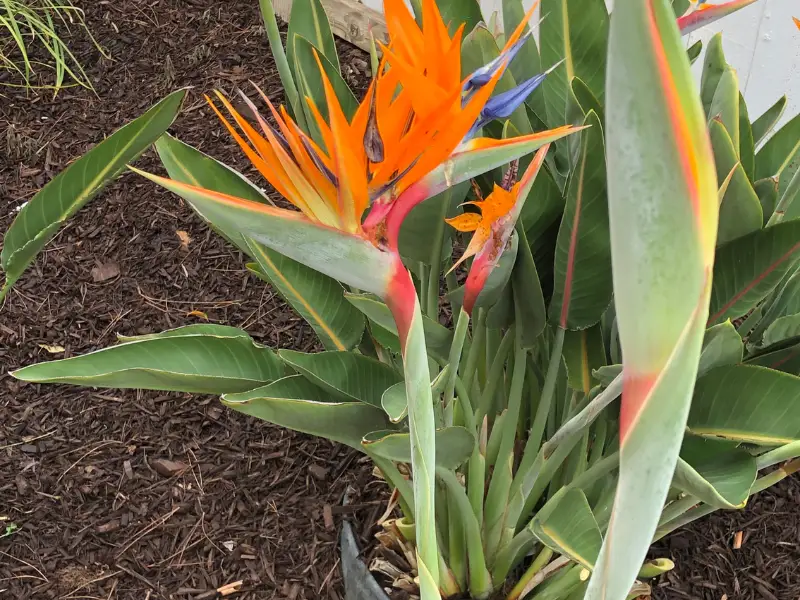
The bird of paradise (Strelitzia spp) is a tropical plant native to South Africa. It’s from the genus Strelitzia, which consists of five varieties of flowering plants. The bird of paradise plant is prevalent in most gardens and yards in the northern states since it’s a warmth-loving plant and doesn’t survive colder winter temperatures below 25oF.
Adding this tropical plant to a household as an indoor plant instantly adds flair and beauty to that space because of its robust, glossy greyish-green or bluish-green leaves resembling those of the banana tree.
When groomed to bloom, it produces brightly colored red, orange, yellow, or blue flowers. The flowers are from a green bract, and their petals’ appearance and arrangement resemble a bird in flight, thus its common name.
The bird of paradise plant needs minimal care to thrive. Irrigating the plant once every 1-2 weeks, placing it in a spot with 6-8 hours of bright indirect sunlight, feeding it with liquid fertilizers, and daily misting is sufficient to maintain it.
Many people often mistake the bird of paradise plant for the traveler’s palm. While their leaves and inflorescence structures look similar, the two are unique.
The birds of paradise leaves are broad and waxy—old leaves split, a feature common in the traveler’s palm leaves. The flowers of the bird of paradise are contained in a light green bract, like the traveler’s palm.
Traveler’s palm
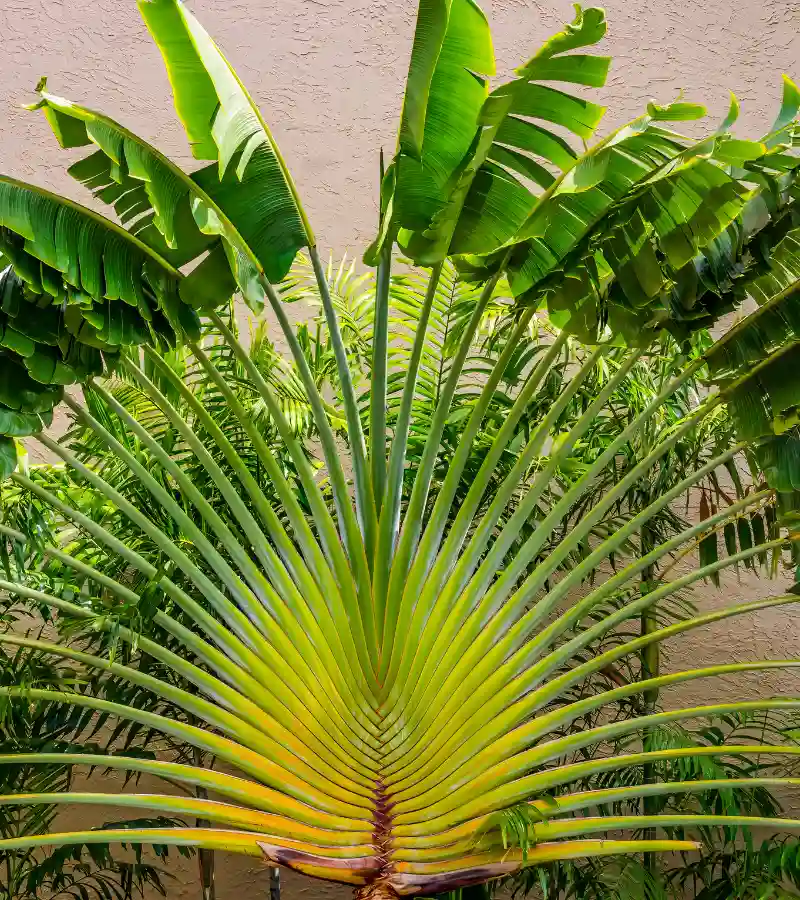
The traveler’s palm (Ravenala madagascariensis), also called the traveler’s tree or East-West tree, is a subtropical and tropical plant native to Madagascar. It belongs to the monocotyledonous flowering plants of the Strelitziaceaefamily and is the only species from the flowering genus of the Ravenala.
The traveler’s palm can be easily mistaken for a true palm, but it isn’t a palm tree. The traveler’s tree has distinctive fan-like structures and foliages from the palm tree.
The leaf bases or the sheaths of the stems of the traveler’s palm are cup-shaped and hollow, collecting about 1 quart of rainwater. Thirsty wandering travelers use this water to quench their thirst, thus the unique name of this plant.
Caution: The water can sometimes be dirty and smelly and should only be drunk after purification.
Furthermore, the leaves and petioles of the traveler’s palm are high above in East-West orientation, which is said to act as a compass point for wandering travelers to direct them.
This beautiful tree has a massive eight-meter long trunk, and a series of long pale-green, two-dimensional petioles arranged in a single plane.
The trunks are mainly fibrous structures with no cambium. However, they are not woody like regular tree trunks. The long leaves are paddle-shaped and emerge from each petiole. The leaves in a tree range from 24-35, depending on the size of the tree. The traveler’s palm can grow tall up to 50 feet high.
The inflorescence of the traveler’s tree spreads along the fan or petioles where the leaves emerge. They are green, less attractive, and contained in a green bract. The flowers are white, and their structures look similar to the Strelitzia reginae and Nicolai.
The flowers have no scent. They have nectar that attracts the tiny lemurs to pollinate them. The flowers produce light blue seeds after successful pollination.
The traveler’s palm and the bird of paradise plant come from the same family Strelitziaeae and thus have an almost similar structural appearance. However, they are from a different genus and species, therefore distinct from each other.
People often mistake the bird of paradise plant for the traveler’s palm because of the close resemblance in their leaves and flowers.
The traveler’s tree has an inflorescence shaped like the bird of paradise. However, its flowers are usually white and contained in a green bract, considered less attractive than the bird of paradise plant.
The leaves of the traveler’s palm are large, measuring up to 5 meters and emerging from the plant’s center.
References
- University of Florida Extension: Ravenala madagascariensis: Travelers tree.
- North Carolina State Extension: Strelitzia reginae.



